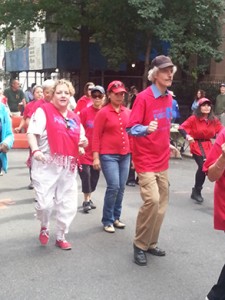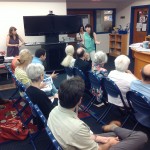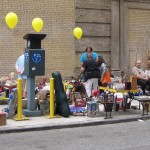Even those of us smitten with “big city living” crave something smaller every now and then. A sense of community is good for society, good for the environment, and good for the soul. But how do you capture that small-town spirit in allegedly anonymous cities like New York?
Luckily that anonymity is a myth. New York City is actually a mass of small towns–aka “neighborhoods”—each possessing its own character, legacy and network of people. Before long, most New Yorkers know their local dry cleaner, deli workers and coffee barista. And if you want to plant even deeper roots, there are plenty of ways to build closer neighborhood ties. As is the case with many things in our beloved city, you might have to work a little harder to do so.
How’s this for an idea? Start a Block Association.
“When you have a neighborhood association, you are creating your own little village; creating a little encapsulated world inside a much larger organism that is a city,” explains Gail Dubov, who heads the West 83rd St, which is believed to be the oldest neighborhood association in New York City. Fifty years ago, a group of dog walkers started the organization in response to the infamous Kitty Genovese murder in Queens in which neighbors failed to respond to her cries for help. Today, Dubov describes spending evenings sitting outside with various neighbors catching up on the news. The group still meets every other month hosting guest speakers such as Borough President Gale Brewer. “I feel like West 83rd is a village,” she says.
On West 75th Street, the block association holds a “Coffee Club” each fall where members set up a table with coffee and additional information. The idea is that anyone from the block can stop by to get to know one another. In addition, the Block Association holds Sunday block promotions, holiday parties and block parties. Upper West Siders can check out this year’s Block Blast on Sunday, September 19th between West End Avenue and Riverside. “The goal is to unite residents and businesses into a culture of caring,” says West 75th Street Block Association president Dee Rieber. “We are the ones people can call when they’ve got an issue.”
These groups can also really make things happen. The West 83rd Street Association recently participated in a pilot program for compositing. In years past, they’ve held auctions offering each other services –i.e. a ride to the airport, two hours of babysitting etc.— and used the proceeds for neighborhood improvements. They’ve contributed to playgrounds, police departments and biking initiatives.
Getting Started
Know what makes your neighborhood tick. Citizens Committee for New York City (http://www.citizensnyc.org/) recommends researching and defining the issues impacting your neighborhood. Are there multiple issues that bring residents together or a single concern, such as
building a community garden? Talk to your neighbors to find out or even pass out a survey. “It’s always best to find something that everyone can rally around,” says Dubov.
Then look into what can be done. As the Citizens Committee for New York City points out: “If your goal is to plant a community garden, for instance, you’ll want to know who owns the available space, how you can get access to it, who in the neighborhood will help with the garden and what resources exist to help you.” Also set a clear definition of who will be included in your association. Is it a single block or an entire neighborhood? How you answer makes a huge difference.
With parameters clearly defined, pull together a core group. This can consist of friends, co-op board members or anyone with a vested interest in the community. Meet with your core people to define goals and divvy up the work. You’ll be amazed to discover your neighbors’ hidden talents.
Finally, get the rest of the community involved through a general meeting. Invite neighbors to attend by passing out flyers. You can even canvas the neighborhood by going door-to-door and introducing yourself. Prepare a few lines of introduction so that your message is clear and consistent.
Once you’ve gotten the word out, plan a general meeting. The Citizens Committee recommends holding the event in a public space, such as a church or community center. Not only is this easy for residents to find, but it also gets these institutions involved from the outset. The meeting itself should be well organized with a clear agenda and plenty of opportunities for people to get involved. And serving coffee and dessert can’t hurt either!
Raising Funds
Most block associations fund themselves via annual membership fees. While some file for tax exemption –a 501(c) status enables members to deduct fees from their taxes—others simply declare themselves a nonprofit without special tax status. The key is to make the membership fees affordable. “We ask members for a $20 membership contribution annually,” says Rieber. “How many lattes is that? It’s a small price to pay.”
For those willing to put in the extra time, there is also various funds available for block associations. Love Your Block initiative provides block associations and other community organization with grants up to $1000 to improve their neighborhood.
Keeping It Going
Building a long-lasting organization goes way beyond fund raising or the initial meeting. Leaders must sustain activity over a long period of time. “Don’t think that you can do something once and get results,” warns Rieber. “It’s about the continuing presence and being there.”
And, in case, any critics ask you “why?”, the West 83rd Street group has come up with the perfect response-slash-tagline: “Because we live here. That’s why.”
Contact us for:
![curballure block xmas photo[9]](http://www.curballure.com/wp-content/uploads/2015/08/curballure-block-xmas-photo9-300x225.jpg)


